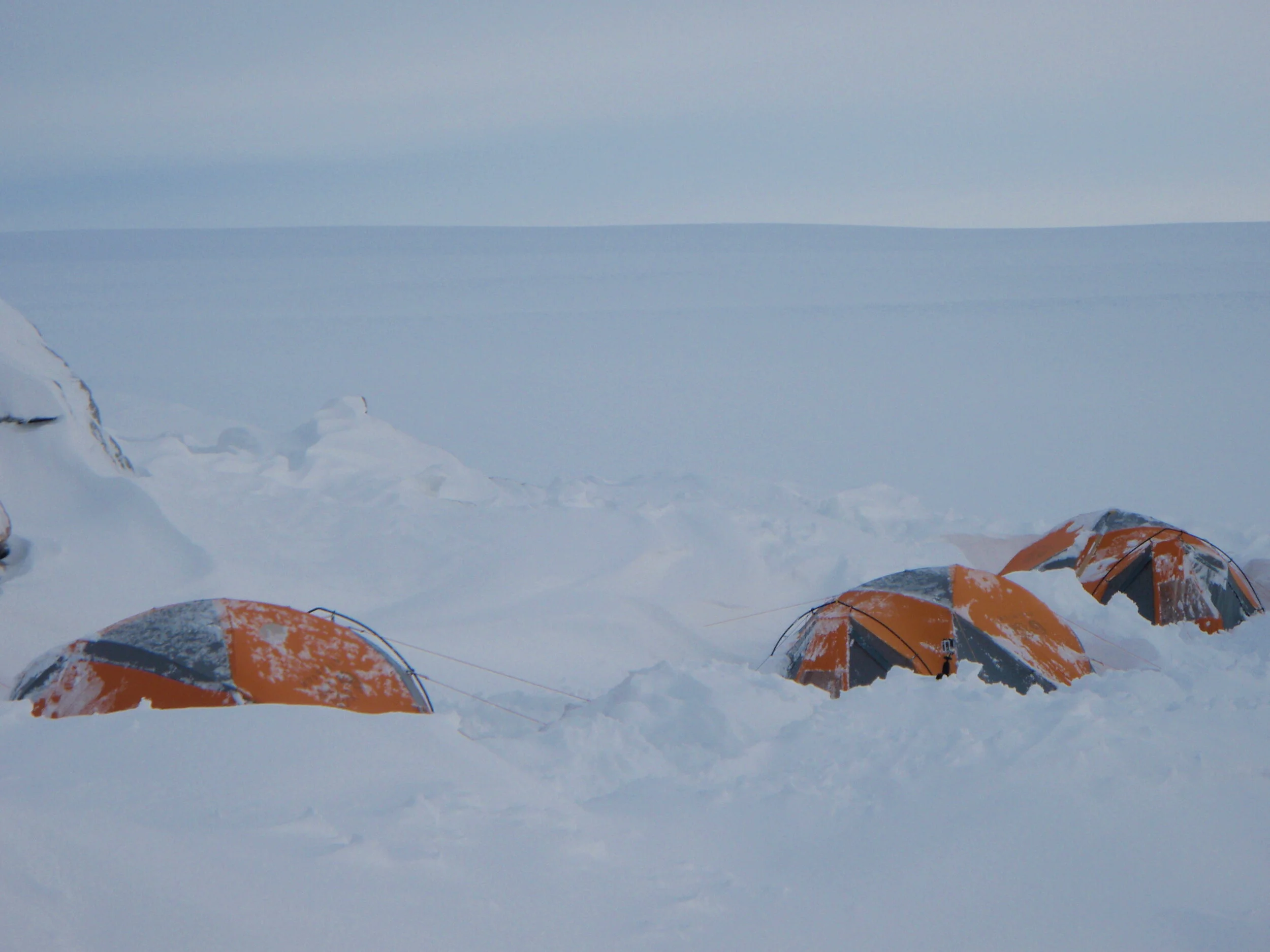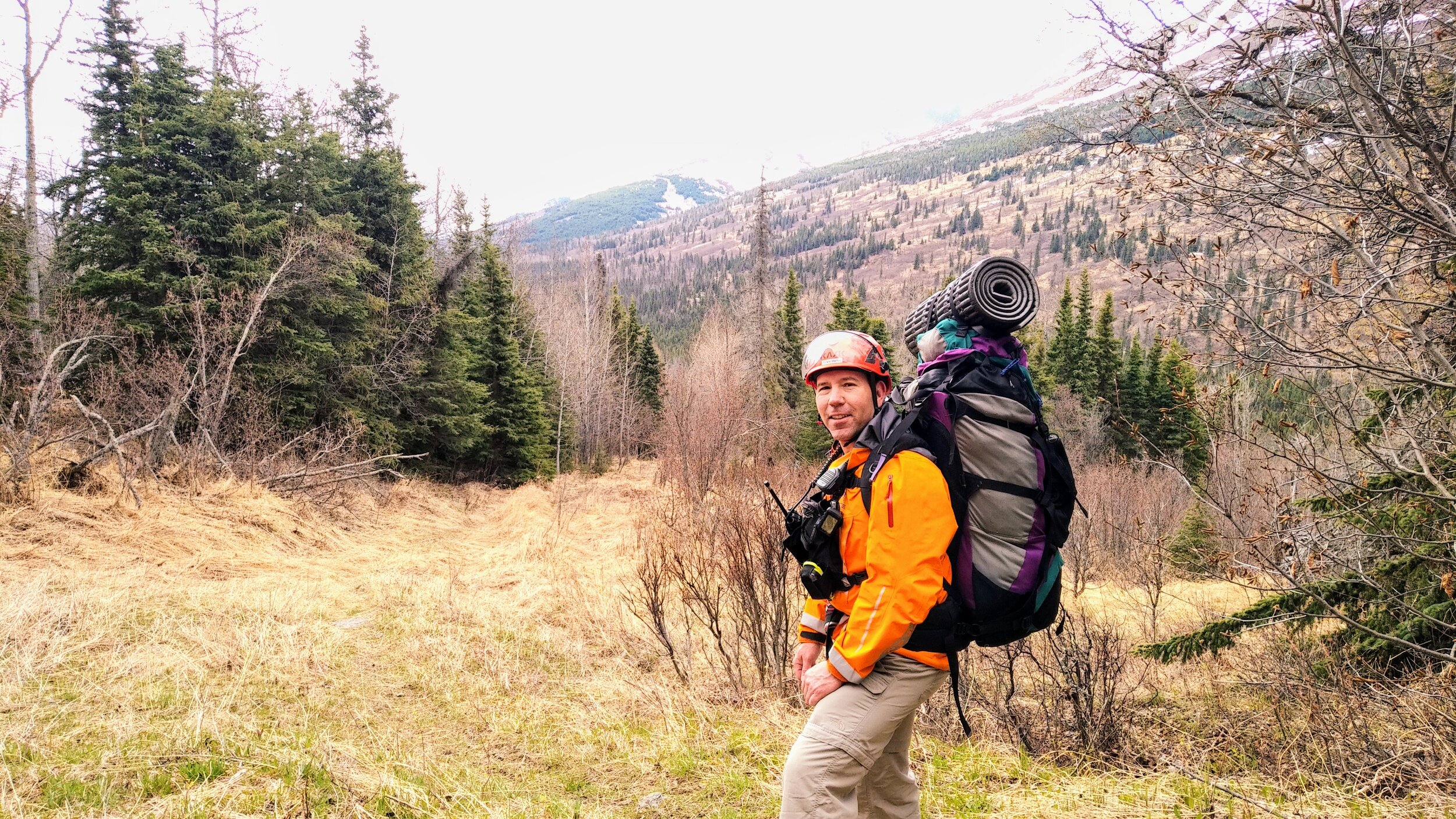A fellow travel writer recently asked me what I would do if disaster struck while I’m on a trip. It was a thought-provoking question and a welcome prompt for organizing the ideas I already had on the subject. As a rule I don’t anticipate any specific situation because it’s difficult to predict the future. Instead I take the approach of planning carefully so if I do find myself amidst a disaster, I have the resources and skills to adapt to the situation. This article suggests some strategies for preparation that can help you navigate adversity if catastrophe strikes mid-journey. To set the stage, here’s a story of the craziest evacuation I have been a part of while traveling.
The conditions in Greenland will destroy even the hardiest tents. Photo by Frank Marley.
When I was working on a search and recovery mission in eastern Greenland my expedition’s base camp was buried under three feet of snow in a 36-hour storm. The mission leader declared an emergency and called for an evacuation. In one chaotic morning we hastily packed our equipment like the Rebel Alliance fleeing their base under Imperial attack in The Empire Strikes Back. One minute I was stacking duffel bags, the next minute a helicopter from the Danish Navy landed next to me. A crew member gave me a survival suit to wriggle into, and soon I was stuffed in the back of the airborne Lynx helicopter. We landed on the aft deck of a frigate in the Greenland Strait to refuel - it was like a Formula 1 pit stop at sea - before flying onward to the airfield at a small village where the Danes deposited us. It was one of the most exciting and bizarre experiences of my life.
Hey, sexy! This immersion survival suit is even less comfortable than it looks. Photo by Joe Tuttle.
Approaching a Thetis-class Danish Navy frigate in its Lynx helicopter. Photo by Nicholas Bratton.
The skill involved in landing a helicopter on the deck of this moving ship at sea was impressive. No room for error. Photo by Nicholas Bratton.
Thank you Danish Navy for carrying some of our team back to Kulusuk in your Lynx. Photo by Nicholas Bratton.
The chances that you will find yourself in this predicament are slim, but the lessons from that episode have shaped my thinking about emergency response in the face of disaster while abroad. Here are ten things you can do to increase your chances of survival if a natural or social emergency strikes in the middle of your trip. Unsurprisingly, these mostly fall under the first principle of Leave No Trace: plan ahead and prepare.
1. Research your destination. What is the political situation? Are certain areas more likely to see unrest? I read the local independent news outlets in the countries I'm visiting to get a sense of the climate. I also read the CIA briefing in The World Factbook. Every traveler should bookmark this reference. It’s not a comprehensive resource, but it provides a good overview.
2. Identify embassy contacts. The US maintains a diplomatic presence in many countries, whether a full embassy or a smaller consulate. The State Department offers a free electronic service (STEP) through which you can sign up to notify them of your travel plans (dates, destinations, and contact info) so the embassy knows you are there and can contact you. This is the easiest and most important thing you can do to ensure that diplomatic resources are available to help you in a crisis. The State Department will also send out alerts if there are political demonstrations occurring in the countries to which you are traveling. I also program the phone number, physical address, and email address of the closest embassy into my travel phone before I leave and share that info with family and friends who are in the US. I will also do the same for the British Foreign and Commonwealth Office, as they sometimes have a diplomatic presence in places where the US does not. Same goes for the French government, depending on the country, but just because I speak French it's no guarantee that they will extend the same help to me as to their own citizens.
3. Learn where the major hospitals are and how to get to them. Program them into your phone.
4. Bring reliable communications equipment and know how to use it. A disaster can disrupt the cellular networks we take for granted. Having a dependable means of communication is an advantage in a disaster. I always buy a local SIM card for my unlocked GSM travel phone. Depending on destination (I tend to seek out very remote places) I may rent a satellite phone with a prepaid block of airtime or use a Garmin inReach device that allows me to send texts via satellite - no cell coverage required. If the local cellular network is overloaded or out of service you have options. Having a backup power source is also a good idea.
5. Have a backup crew. I give my travel details to the most capable, persistent, and creative friend I have at home. This includes my itinerary, names of camps and hotels and towns I'll be in (where and when), plus the same diplomatic contact information I carry. Having a competent advocate who can communicate on your behalf from back home could help muster resources you can’t access from abroad.
6. Carry travel and rescue insurance. Buying trip insurance is a common practice, but what about rescue insurance? As a member of the American Alpine Club I get $7,500 of coverage for rescue anywhere in the world, but anyone can buy a trip policy through Global Rescue directly. You can call them (Global Rescue) 24/7 from anywhere, but be aware that your request may not be the only one they are responding to in an emergency.
7. Be as self-sufficient as possible. Bring your own first aid kit and water purification, even if traveling to a highly developed country.
8. Pack light. If you need to move fast, you don't want to lug around a heavy suitcase. Here is some guidance on packing.
9. Carry cash. Electronic payment may not be possible in a catastrophe and having cash will be essential to pay for goods and services. Take currency that is appropriate to where you're going. US dollars won’t be a big advantage in the Eurozone, but in southern Africa everyone will want your greenbacks.
10. If you can, offer help. Do you have skills or resources that can be valuable in a catastrophe, whether medical, technological, logistical, or linguistic? Look for ways to contribute to the response instead of using resources trying to leave. Your individual well-being is top priority and how to respond is your personal decision, but if you can do so safely, consider offering assistance. Can you use your 4-wheel drive vehicle to transport injured people to a hospital? Can you deliver supplies? Can you help fellow travelers communicate with their families? Can you act as eyes and ears for international aid efforts? Can you make a financial donation to a local charity? Part of being a good traveler is understanding that you are an ambassador of your home country. This is the case whether in hard times or good. Be generous, be kind, and keep a positive attitude.
My friend and colleague Frank Marley shared a few thoughts on his mitigation of disaster risk while traveling. He’s a major in the Alaska National Guard and also works with the Alaska Mountain Rescue Group. Having served as an army medic in Afghanistan, Mongolia, and eastern Europe, he brings a practical perspective to preparation.
Frank Marley in the Alaskan wilds.
Frank recommends traveling with the following items and being selective about room choice in hotels:
1. Color copies of my passport photo page that I stash in different locations. In the event of loss/theft of the passport I have proof of the document.
2. One to three 2-gallon zippered plastic bags. These have numerous uses that become evident when the weather turn rainy (protecting travel documents, maps, electronics).
3. One 42-gallon or larger 3-mil contractor trash bag. This can serve as improvised rain gear, pack cover, suitcase cover, etc.
4. Twenty feet of strong, lightweight cordage (parachute cord). This is another versatile item and can work as replacement shoe/boot lace, clothes line, gear repair, etc.
5. One or two feet feet of duct tape rolled on tube of lip balm for gear repair or first aid.
6. Disinfecting wipes or hand sanitizer for self protection and for wiping down your personal space while traveling. Volume restrictions have now been increased.
7. Augmented first aid kit with extra 3" x 3" or 4" x 4" gauze pads, a tube of polysporin/neosporin and a simple tourniquet such as a RATS. Whichever type you select just make sure you know how it works before you chuck it in your bag.
If staying at a hotel I insist on rooms that are not on the first floor or near elevators or stairwells. Rooms further from these features are more secure and less likely to be targeted by attackers.


